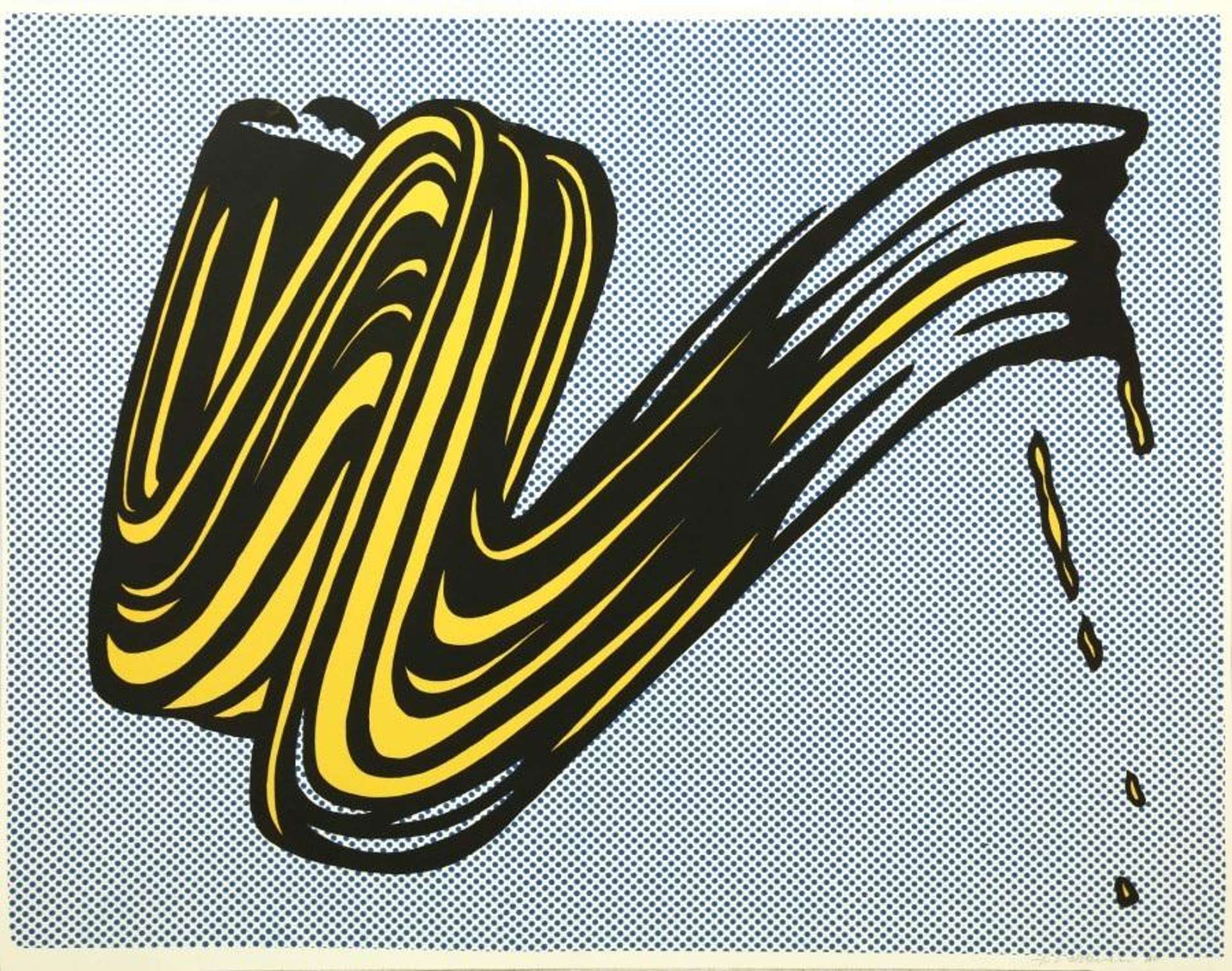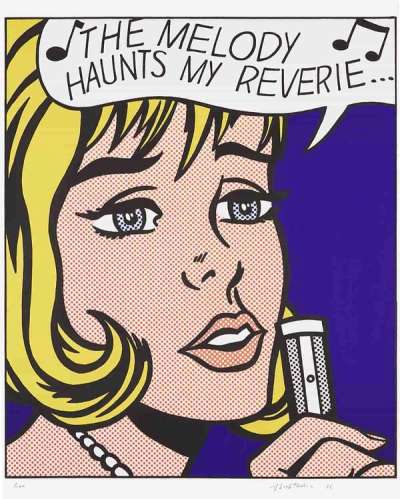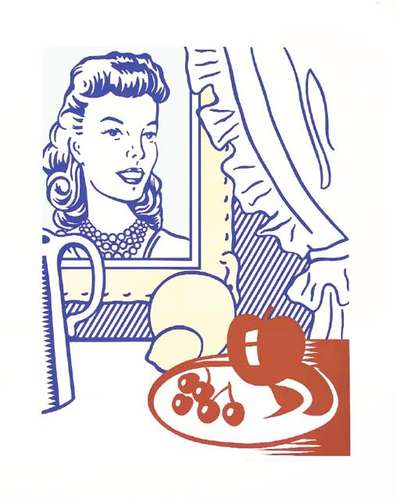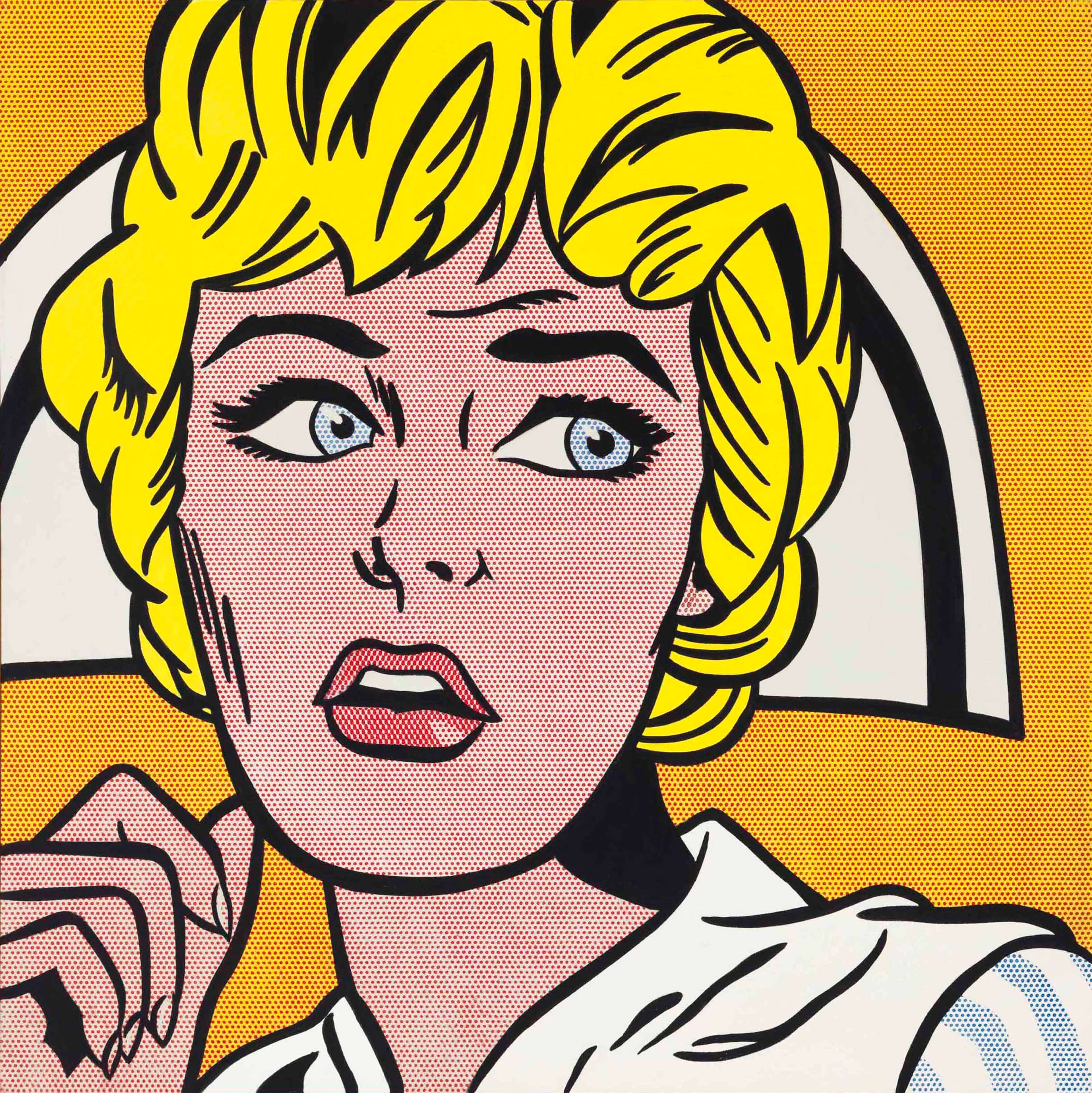 Vicki! I-I Thought I Heard Your Voice! © Roy Lichtenstein 1964
Vicki! I-I Thought I Heard Your Voice! © Roy Lichtenstein 1964
Roy Lichtenstein
287 works
Few artists have the ongoing influence of Roy Lichtenstein. He first rose to fame with his reproductions of comic book panels, but it was his ability to tackle contemporary culture and subjects that made him a true Pop Artist. Here are 10 things to know about Lichtenstein’s Pop Art paintings, from the iconic to the introspective and experimental.
Lichtenstein’s first Pop Art painting was Look Mickey in 1961
Look Mickey was Lichtenstein’s first comic book-inspired artwork, marking the style that he is now so well-known for. The painting was derived from the 1960 book Donald Duck Lost and Found, owned by one of the artist’s sons. Lichtenstein first created his iconic Benday dots by pushing oil paint through the holes of a plastic dog-grooming brush without its bristles. Over the next year, Lichtenstein produced several more pieces inspired by comic-strip characters, such as Popeye and Buck Rogers.
Themes of conflict and war dominated many of his 1960s Pop Art paintings
Arguably the most famous of Lichtenstein’s works, Whaam! from 1963, took its inspiration from the 1962 comic All American Men of War. “At that time I was interested in anything I could use as a subject that was emotionally strong – usually love, war, or something that was highly-charged and emotional subject matter,” the artist explained. War was a very real and serious threat at the time – the Vietnam War was escalating and America would join the fight a year later – but Lichtenstein’s cartoon style made the subject simultaneously more poignant and detached for the viewer.
Lichtenstein’s Pop Art addressed the romantic plights of 1960s girls… and himself
From the drowning girl who would rather sink than call Brad for help to lovelorn singers and crying girls, many of Lichtenstein’s early paintings explored women’s struggles with men and love in popular culture, all characterised by striking close-ups of their distressed faces.
Around the same time that he was painting these works, Lichtenstein divorced his first wife and was channelling his frustrations into his art. As his ex-girlfriend Letty Eisenhauer later said in an interview, Lichtenstein “was full of feelings that were hard for him to talk about — and the paintings often became a vehicle for them.”
 Masterpiece © Roy Lichtenstein 1962
Masterpiece © Roy Lichtenstein 1962Masterpiece reflected Lichtenstein’s hopes for fame and recognition
Masterpiece, painted in 1962, embodied Lichtenstein’s most recognisable techniques: Benday dots, cultural references, expressive female faces, and speech bubbles that indicate the viewer has been dropped right into the middle of the action. The female companion’s encouragement – “Why Brad darling, this painting is a masterpiece! My, soon you’ll have all of New York clamoring for your work!” – has been interpreted as Lichtenstein’s own ambitions for his art.
In 2017, billionaire hedge-fund manager Steve Cohen purchased Masterpiece for $165 million in a private sale, making it one of the 10 most expensive paintings ever sold at the time.
The most expensive Lichtenstein Pop Art painting at auction sold for $95.4 million
Nurse, from 1964, was inspired by a comic book panel from the early 1960s. But like many of Lichtenstein’s works, the image has been altered to create more drama. When it was offered at Christie’s in New York in 2011, it set a new auction record for a Lichtenstein painting. Ironically, Nurse was painted in the same year that Life magazine released an article questioning if Lichtenstein was ‘The Worst Artist in the U.S?’.
Lichtenstein tore down the boundary between high and low art
Lichtenstein broadened out from pop culture subjects from the mid-1960s and his work started to critique trends in the art world itself. His Brushstrokes was a direct commentary on the Abstract Expressionism movement. As many Pop Artists strived to do, Lichtenstein wanted to break down the distinction between the ‘high brow’ art of the galleries and ‘low brow’ mass-market art forms – Brushstrokes achieved this by drawing attention to the basic act of painting that underlined both artistic movements.
Lichtenstein reproduced other artworks throughout his career
Many of Lichtenstein’s most famous paintings from the 1960s were inspired by comic books, although he changed significant details. But even after he moved away from comic book subjects in the 1970s and 1980s, Lichtenstein believed copying other artists to be a necessary part of art. “Artists have often converted the work of other artists into their own style,” he said, referencing his interpretations of Monet’s Haystacks and Surrealism.
 Still Life With Portrait © Roy Lichtenstein 1974
Still Life With Portrait © Roy Lichtenstein 1974Lichtenstein used his comic-book style to deconstruct historic masterpieces
Still Life With Portrait, from Lichtenstein’s Six Still Lifes series, contrasted themes often found in European Old Master paintings – such as fruit, a jug and draping fabrics – with modern printing marks like Benday dots and bright, cartoonish colours, along with his idealised, comic-book heroine.
“When we think of still lifes, we think of paintings that have a certain atmosphere or ambience. My still life paintings have none of those qualities, they just have pictures of certain things that are in a still life, like lemons and grapefruits and so forth,” said Lichtenstein. “It’s not meant to have the usual still life meaning.”
Lichtenstein’s Pop Art has been influencing fashion designers for decades
In 1991, Moschino used Lichtenstein’s painting Good Morning… Darling! on a skirt and jacket suit. Vivienne Westwood created a make-up look inspired by Lichtenstein’s Baked Potato. Rita Ora referenced Lichtenstein’s ceramic Head with Blue And Red Shadows in her 2015 collection for Adidas Originals.
Lichtenstein returned to comic books in his final series
Lichtenstein’s Nudes series in the 1990s saw him return to the idealised women that populated his early works. Unlike his Pop Art heroines from the 1960s, which were taken from recently published comic books, Nudes was the artist looking back at these comic books three decades on. The technique evolved too: Lichtenstein’s once-uniform Benday dots had a lot more variation, with emphasis on shadow and depth. Combining all of Lichtenstein’s key subjects and styles, Lichtenstein’s final painting Interior With Nude Leaving was the perfect conclusion to his career.
Browse Lichtenstein prints for sale or contact us to sell a Lichtenstein print.

















